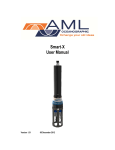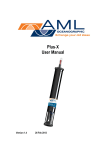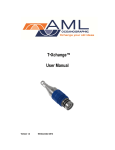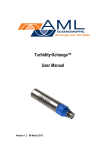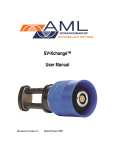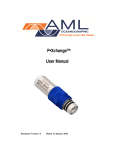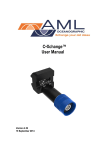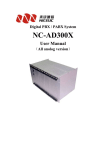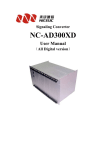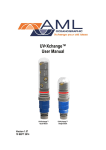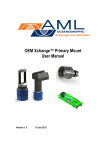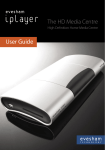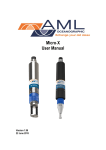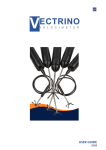Download Metrec•X - User Manual
Transcript
MetrecX User Manual Version 1.61 18 September 2015 Revision History Revision Date Description Author Version 1.0 08 May 2012 First Version of Manual Matt Tradewell Version 1.1 29 June 2012 Updates Erika Ladouceur Version 1.2 05 July 2012 Updates Erika Ladouceur Version 1.3 06 March 2013 Added Supported Sensor Configurations Table Dustin Olender Version 1.4 12 June 2013 Format revision and updates Jehan Zouak Version 1.5 26 August 2013 Minor Edits Jehan Zouak Version 1.51 12 February 2014 Added UV•Xchange references Chris Bueley Version 1.52 16 July 2014 Added Ordering Codes Jehan Zouak Version 1.53 1 August 2014 Edited voltage values Jehan Zouak Version 1.54 06 October 2014 Updated Calculated SV Dustin Olender Version 1.55 26 March 2015 Updated Power Consumption table and added Acetal version Quinton Calverley Version 1.56 30 March 2015 Added ordering code and reference Jehan Zouak Version 1.57 12 May 2015 Added CSE-0026 Jehan Zouak Version 1.58 22 June 2015 Technical specification updates Jehan Zouak Version 1.59 24 July 2015 Information for the UV option added Andrew Beak-Taylor Version 1.60 24 August 2015 Independent UV option updates Jehan Zouak Version 1.61 18 September 2015 Updated Independent UV option drawing Jehan Zouak User Manual for AML Oceanographic’s Metrec•X Table of Contents General Description of the Instrument .............................................................................................. 2 Where Do I Start? ............................................................................................................................ 3 Shipping & Receiving ....................................................................................................................... 4 Receiving an Instrument .............................................................................................................. 4 Returning an Instrument to the Factory........................................................................................ 4 Using the Instrument ........................................................................................................................ 5 Pressure Ratings ......................................................................................................................... 5 Pre-Deployment Procedures........................................................................................................ 5 Supported Sensor Configurations ................................................................................................ 6 LED Indicator ............................................................................................................................... 7 Configuring Sampling Parameters Using SeaCast ...................................................................... 7 Configuring Sampling Parameters with HyperTerminal ............................................................... 7 Accounting for Atmospheric Pressure Variations at the Surface .................................................. 8 Logging a Profile .......................................................................................................................... 8 Monitoring Real Time Data .......................................................................................................... 9 Post-Deployment Procedures ...................................................................................................... 9 Viewing your Data........................................................................................................................ 9 Metrec•X with Independent UV .................................................................................................... 9 Maintaining the Instrument ..............................................................................................................11 Periodic Maintenance .................................................................................................................11 Communications .............................................................................................................................12 PC Settings .................................................................................................................................12 Output Formats ...........................................................................................................................12 Default Output Format...........................................................................................................12 Default Example Outputs ......................................................................................................13 Support ...........................................................................................................................................16 Troubleshooting ..........................................................................................................................16 Contact AML Oceanographic ......................................................................................................18 Appendices .....................................................................................................................................19 Commands .................................................................................................................................19 Communications Commands ................................................................................................19 Sampling Rate Commands ...................................................................................................19 Output Format Commands....................................................................................................20 Logging Commands ..............................................................................................................20 General Commands ..............................................................................................................21 Technical Specifications .............................................................................................................22 Ordering Codes ...............................................................................................................................27 Warranty .........................................................................................................................................29 Technical Overview Drawings .........................................................................................................30 1 User Manual for AML Oceanographic’s Metrec•X General Description of the Instrument AML Oceanographic X•Series instruments and XchangeTM sensors are a major advancement in ocean instrumentation. Swappable and interchangeable sensors dramatically improve the capabilities of ocean instrumentation in the following ways: Change the instrument sensor types while at sea within seconds, and without tools. A CTD can be changed to a sound speed profiler by exchanging sensor heads. To optimize the resolution and accuracy of sensor data, sensors can be swapped to change the measurement range. For example, a 6000 dBar P•Xchange pressure sensor can be swapped with a 500 dBar P•Xchange sensor; the salt water C•Xchange conductivity sensor can be swapped for a fresh water C•Xchange conductivity sensor. Sensors from one instrument can be swapped to another instrument to maintain missioncritical capabilities. Calibrated sensors can be sent from the factory to the instrument. The instrument is not pulled from active duty for calibration. Spare sensors ensure that an instrument can be immediately returned to active duty after sustaining damage. All calibration and traceability data resides within each XchangeTM sensor. Calibration data for all sensors is available from the instrument, and calibration certificates can be printed from AML Oceanographic SeaCast software when the instrument is connected. Logged data is stamped with sensor traceability and instrument configuration data. Only XchangeTM sensors are sent for calibration, leaving the instrument working in the field. Metrec•X is an externally-powered, multi-parameter instrument that allows you to change the instrument’s sensor load, in the field and on-demand. The instrument can output data in real-time and log data to its internal memory simultaneously. Metrec•X may be equipped with multiple primary Xchange™ sensor ports (C•Xchange or SV•Xchange) and multiple secondary Xchange™ sensor ports (T•Xchange, P•Xchange, Turbidity•Xchange, UV•Xchange). Sampling rates are set by time (2 Hz to every 24 hours), by pressure (0.1 dbar or greater increments), or by sound speed (0.1 m/s or greater increments). Supported communication protocols for Metrec•X are RS-232 or RS-485. The instrument must be connected to a power supply capable of supplying +8 to 26 VDC with minimal line noise. Any Metrec•X with a P1S4 configuration is compatible with UV•Xchange. Additionally, there is an “independent UV” option featuring a secondary port dedicated specifically to UV•Xchange. This separately powered port includes a Duty Cycle Controller to minimize power use while maximizing the effectiveness of the biofouling control system. It is wired internally into a Micro-6 connector and is powered through two dedicated lines on the communication cable. 2 User Manual for AML Oceanographic’s Metrec•X Where Do I Start? AML Oceanographic X•Series instruments ship with several manuals on the USB stick: An instrument manual (this Metrec•X manual) providing an overview on how to use and maintain the instrument; A SeaCast manual providing instructions on how to use the software to configure the instrument and review instrument data; Xchange™ sensor manuals (C•Xchange™, SV•Xchange™, P•Xchange™, T•Xchange™, Turbidity•Xchange™ and UV•XchangeTM) providing overviews on how to install and maintain each of the Xchange™ sensors; If you are configuring an instrument for field use or lab testing, begin with the SeaCast manual. If you are performing instrument maintenance, begin with the instrument manual. If you are planning to swap an Xchange™ sensor, read the Xchange™ manual corresponding to your sensors. If Metrec•X is equipped with UV•Xchange, refer to the UV•Xchange manual. 3 User Manual for AML Oceanographic’s Metrec•X Shipping & Receiving Receiving an Instrument When receiving an instrument, perform the following steps to ensure the instrument will be ready for deployment when required: Inspect the shipping container, looking for signs of damage. Damage to the shipping container could indicate damage to the instrument inside. The shipping package should include all of the following items o Metrec•X instrument o Data/Power cable o Black dummy plug o Two primary sensor blanking plug o Two secondary sensor blanking plugs o USB stick with manuals and documentation Check for damage o Check the cable for slices or gouges o Check the connector sockets for corrosion, dirt, and salt deposits o Check the pressure case for dents and scrapes o Check the sensors for cracks or bends Ensure all the Xchange™ sensors are installed tightly onto their mounts. The blue locking sleeve should be tight, and sitting less than 1mm from the instrument end cap. Connect the instrument to a computer with the data cable and perform a scan or monitor if using SeaCast. Returning an Instrument to the Factory If shipping for repair or recalibration, obtain an RMA number from the service centre. Pack the instrument in its original shipping box to prevent damage during shipping. An RMA number can be requested using the contact options given in the Support section of this manual 4 User Manual for AML Oceanographic’s Metrec•X Using the Instrument Pressure Ratings Pressure ratings are given for Xchange™ sensors and the entire instrument. Deployments should never exceed the lower of these two pressure ratings. For example, a 500m instrument equipped with a 6000 dBar (0-6000m) P•Xchange™ sensor is limited to deployments of 500m depth or less. Similarly, a 6000m instrument equipped with a 500 dBar (0-500m) P•Xchange™ sensor is also limited to deployments of 500m depth or less. It is desirable to optimize the accuracy of pressure measurements by using a P•Xchange™ sensor with a pressure range that closely matches the depth of the deployment. Caution: Do not exceed the specified pressure ratings of the P•Xchange™ sensor, Turbidity•Xchange™ sensor, or the instrument housing. Turbidity•Xchange™ sensors are limited to deployments of 500m of less, regardless of the pressure rating of the instrument on which they are installed. Overpressure can result in damage to the sensors and the instrument. Pre-Deployment Procedures Upon Receipt o Use the Shipping and Receiving instructions to verify the condition of the instrument. o Verify that all sensor calibrations are valid for the duration of the deployment. If not, swap the Xchange™ sensors for sensors with valid calibrations or send the Xchange™ sensors to a service centre for recalibration. o Lightly lubricate the underwater connectors with 3M silicone spray or equivalent. Before leaving the jetty o If applicable, verify the P•Xchange™ pressure range is correct for the deployment. o Connect the instrument to a computer using the data cable. o Check the instrument memory Save any unsaved memory files. Initialize the memory (Note: This deletes ALL files stored in the instrument memory. Be sure to have a copy of all important logged data before performing this step.). If using SeaCast, click the Clear Memory box. If using a Terminal Emulator, send instrument an INIT command. Caution: Install blanking plugs in all unused sensor ports prior to deployment. Failure to install blanking plugs will result in damage to the connectors. C•Xchange™ & SV•Xchange™ blanking plug T•Xchange™, P•Xchange™ & Turbidity•Xchange™ blanking plug 5 User Manual for AML Oceanographic’s Metrec•X Supported Sensor Configurations Primary Port Elevated C•Xchange™ SV•Xchange™ Secondary Port Lower T•Xchange™ P•Xchange™ Turbidity•Xchange™ Secondary Port Upper T•Xchange™ P•Xchange™ UV•XchangeTM Metrec•X endcap with one primary and four secondary ports (abbreviated as P1S4). Blanking plugs shown installed. Metrec•X endcaps are available with different combinations of ports to allow for a wide variety of sensor combinations. Swappable sensors allow you to configure your instrument in a number of different ways. See tables below for two endcap styles and popular sensor combinations. Note that not all supported sensor combinations are shown. It is possible, for example, to install two T•Xchange™ sensors, or two P•Xchange™ sensors simultaneously for cross verification, or in the case of Turbidity•Xchange™, using two different ranges to capture both high and low events accurately. Port Type Port Level 1 2 3 4 P2S2 Endcap Primary (P2) Elevated ↑↑ Upper ↑ C SV C SV C SV C SV Secondary (S2) Upper ↑ Lower ↓ T P P T T Turbidity P Turbidity P1S4 Endcap Port Type Port Level 1 2 3 4 Primary (P1) Elevated ↑↑ C C SV SV Secondary (S4) Upper ↑ Upper ↑ P UV•Xchange T UV•Xchange P UV•Xchange T UV•Xchange Upper ↑ T P T P Lower ↓ Turbidity Turbidity Turbidity Turbidity Note that UV•Xchange is only compatible with P1S4 style endcaps and may require configuration particular to the sensor payload installed. Refer to UV•Xchange manual for configuration details. 6 User Manual for AML Oceanographic’s Metrec•X LED Indicator The LED indicator is located next to the data/power connector on the instrument top end cap. The LED indicator will be on whenever the data/power cable is plugged into the instrument. The instrument will not start logging until it is immersed in water and it takes its first sample at the programmed sampling rate. The LED indicator displays are as follows: LED is a constant green: This indicates the instrument is on and the external power is greater than 9.9V LED is flashing green: The instrument is logging data and the external power is greater than 9.9V LED is a constant red. This indicates the instrument is on and the external power is less than 9.9V. Try to supply power at higher voltage for best reliability. LED is flashing red. The instrument is logging data and the external power is less than 9.9V LED is off with data/power cable attached. The instrument is not working properly. Consult the troubleshooting section or call the service department. Configuring Sampling Parameters Using SeaCast Please refer to the SeaCast Manual. Configuring Sampling Parameters with HyperTerminal Instruments can also be configured for deployment using HyperTerminal or other terminal emulation programs. As with SeaCast, communications with the instrument must be established using the correct communications port and settings. The communications settings are 8 data bits, 1 stop bit, no parity, no flow control, and the desired baud rate. The following steps must be completed by issuing text commands: Step Possible Commands Initialize Memory (erases instrument memory) INIT Set Log File Name SET LOG filename.txt Set Instrument Time & Date SET TIME hh:mm:ss SET DATE mm/dd/yy Set Sampling Parameters SET SAMPLE RATE CONTINUOUS SET SAMPLE RATE 5/s SET P INC 1 SET SOUND INC 2 The above table provides example commands only; many additional sampling regimes can be established using available commands. Please consult the Commands section of the Appendix for full syntax details on the commands you wish to use. 7 User Manual for AML Oceanographic’s Metrec•X Accounting for Atmospheric Pressure Variations at the Surface Climate and altitude changes can create fluctuations in atmospheric (barometric) pressure. AML's pressure sensors are sensitive enough to detect these variations. When this happens, the instrument's pressure channel may not read exactly zero when data is taken prior to submersion in the water. Nearly all absolute pressure sensors experience atmospheric pressure offsets if they are sufficiently sensitive. To compensate for this atmospheric pressure offset, AML instruments have the ability to reset the pressure sensor's zero point. This can be initiated using AML Oceanographic SeaCast software or a Terminal emulator command. The compensation does not affect the calibration of the pressure sensor, and can be turned off or recalculated at any time. The compensation factor is applied through the entire calibrated pressure range. Note that this compensation cannot be applied to a built-in Paroscientific Digiquartz sensor, as found in bathyMetrec•X. Once the atmospheric pressure compensation is applied, it will be applied to all pressure sensor data until it is turned off or recalculated. The setting is written to memory, so it remains set when the instrument is powered down. Using SeaCast Refer to the SeaCast User Manual for instructions on enabling "Zero Depth." Using a Terminal Emulator Establish serial communications with the instrument on your computer. Refer to the "Communications" section of this manual for more information. Once connection is established, ensure the instrument is stationary, and is not submerged in water. To turn ON Atmospheric pressure compensation, issue the ZERO ON command. This will calculate and apply the offset required to compensate for current atmospheric pressure conditions. To turn OFF Atmospheric pressure compensation, issue the ZERO OFF command. This will disable the offset. Issuing the ZERO command again will calculate a new offset based on current conditions. Logging a Profile Ensure the pre-deployment procedures have been completed (see page 5). Metrec•X is a real-time instrument with the ability to log data. To enable logging, send the command SET SCAN LOGGING to the instrument (see Commands section). Plug the data/power cable into the instrument. Ensure that the desired sampling settings have been selected and applied. With the instrument in air (NOT submerged), use the ZERO command to zero the barometric pressure offset (P•Xchange™ only). Enter the M or MONITOR command to begin monitoring data. All monitored data will be logged, provided the SET SCAN LOGGING command is enabled. The status LED should start to flash green to indicate data is being logged. Keep the instrument at this depth for 2 minutes prior to beginning the cast. This allows time for the sensors to fully wet and for the pressure case to shed heat. 8 User Manual for AML Oceanographic’s Metrec•X Send the instrument down to the desired depth and return it to the surface. Monitoring Real Time Data Ensure the pre-deployment procedures have been completed (see page 5). Ensure that the desired sampling settings have been selected and applied. Plug the data/power cable into the instrument. If you power the instrument externally over a long cable, please note the following: o Voltage drop due to cable resistance increases with cable length. The voltage drop on a standard AML cable, with a standard bathyMetrec•X, is about 2 volts per 100m of cable while sampling and 0 volts per 100m when in low power mode. o The instrument’s low voltage warning triggers at 9.9 volts or less. o The instrument’s auto shutdown triggers when supplied with 8.0 volts or less. o The instrument’s maximum voltage is 36 volts. o The voltage at the instrument, while sampling, must be above the shutdown level for the instrument to operate. With the instrument in air, use the ZERO command to zero the barometric pressure offset (P•Xchange™ only). Lower the instrument until the sensors are fully submerged; the LED should start to flash green. Keep the instrument at this depth for 2 minutes prior to beginning the cast. This allows the sensors time to wet, and the pressure case to shed heat. Begin monitoring data using SeaCast or HyperTerminal. Send the instrument down to the desired depth and return it to the surface. Post-Deployment Procedures When the instrument is pulled from the water it should be rinsed with fresh water. Dry the area around the connectors with a clean cloth or compressed air prior to disconnecting the plugs or cables. Do not blow compressed air into the Pressure•Xchange™ sensor. Doing so may damage the sensitive pressure transducer diaphragm. Remove the cable. Place the dummy plug in the connector to protect it. Dry the instrument and stow it securely. Viewing your Data You may download and view data using SeaCast or HyperTerminal. Please refer to the SeaCast manual to which outlines the steps to download and review your data. Metrec•X with Independent UV The independent UV option is offered for situations where economic power usage is critical but biofouling protection is still desired. By running the UV independently through a DCC, the instrument can take advantage of all its power saving features, shutting down between measurements while UV•Xchange continues to prevent fouling uninterrupted on a different power source. If the independent UV option is selected, the Metrec•X will be configured as a P1S3+UV, which is a P1S4 where one of the secondary ports is dedicated to UV•Xchange. This port is marked with “UV ONLY.” 9 User Manual for AML Oceanographic’s Metrec•X Configuration of the Duty Cycle Controller The default setting for the DCC is a repeating pattern of 20 minutes on and 20 minutes off. This can be configured at user request for any combination of 2-minute increments in a repeating 120minute period. The on-off timer begins immediately once the controller is supplied with power. Note: If powered through the dedicated port, configuration options for the UV•Xchange will not be accessible through SeaCast. Power Power to the UV port is independent from the rest of the instrument. If the independent UV option is selected, two pins on the connector that are normally unused are activated for this purpose. Pin 5 Pin 6 UV VDC UV GND Power must be supplied continuously. When the DCC is in an "on" cycle, power is passed through to the device connected to the output. No power is passed to the output during an "off" cycle. The timing board itself consumes less than 0.1mA during both "on" and "off" cycles. 10 User Manual for AML Oceanographic’s Metrec•X Maintaining the Instrument Periodic Maintenance Periodic preventative maintenance will prolong the life of the instrument. The following steps are recommended: If the instrument is very dirty or oily, allow it to soak in warm, soapy water before cleaning with a rag or soft brush. When finished, rinse with fresh water to remove any residual soap or dirt. Before each use: o Check for proper installation of all Xchange™ sensors. o Check for nicks and cuts on the cable. After each use: o Clean and rinse the instrument using fresh water. o Dry the instrument completely, and store it in a cool, dry place. Monthly: o Lightly lubricate the connector contacts with 3M silicone spray or equivalent. Avoid the use of grease. It can create internal pressure and push past the connector seals on the pins. o Lubricate the end cap retainer rings with silicone grease. Yearly: o Send the instrument or Xchange™ sensors to a service centre for diagnostics and re-calibration. 11 User Manual for AML Oceanographic’s Metrec•X Communications PC Settings Metrec•X will communicate with both RS-232 and RS-485 serial connections. The computer to which the instrument is connected must be set up as follows: 8 bits 1 stop bit No parity No hardware flow control Baud rate of 600, 1200, 2400, 4800, 9600, 19200, or 38400 baud After power up, the Metrec•X will wait for an ASCII carriage return. The instrument will automatically detect whether communications are RS-232 or RS-485 as well as the baud rate. Output Formats Output formats can be modified. If the required modifications are not supported by the commonly used command list in the next section, please contact the factory for support with custom output formats. Formatting can be changed in the following ways: The number of decimal places for each channel Turn on or off o date and time o calculated parameters (salinity, density and calculated SV) o power up information (header) o automatic monitoring on power up Default Output Format The output from Metrec•X is space delimited values. The following table shows the output units for each Xchange™ sensor: Sensor Units Default Format SV•Xchange™ m/s 1234.567 Conductivity•Xchange™ mS/cm 12.346 Pressure•Xchange™ dBar 1234.56 Temperature•Xchange™ C 12.345 Turbidity•Xchange™ NTU 1234.56 UV•Xchange™ - 1 (1 indicates UV on, 0 indicates UV off) 12 User Manual for AML Oceanographic’s Metrec•X The default data channel outputs with all calculated parameters turned on are the following: P1S4 Configuration (with SV, P, T, and Turbidity sensors) Date Time Sound velocity Pressure Temperature Dissolved Oxygen Turbidity Battery Density Salinity mm/dd/yy hh:mm:ss.ss m/s dBar C mg/L NTU volts kg/m3 ppt P2S2 Configuration (with SV, C, P, T sensors) Date mm/dd/yy Time hh:mm:ss.ss Sound Velocity m/s Conductivity mS/cm Pressure dbar Temperature C Battery volts Density kg/m3 Salinity ppt Calc SV m/s Note: These are examples of the default configurations. Your data channel outputs will be entirely dependent on which XchangeTM sensors are installed. Default Example Outputs Keyboard inputs in the output capture shown below are in bold type. METREC.X Version 4.13.10 SN:50002 AML Oceanographic Ltd. 969.0 MBytes installed scan > 05/08/12 12:56:06.54 1486.164 00.076 -0000.13 21.244 009.85 monitor > 05/08/12 12:56:08.26 05/08/12 12:56:08.32 05/08/12 12:56:08.37 05/08/12 12:56:08.44 05/08/12 12:56:08.51 05/08/12 12:56:08.58 05/08/12 12:56:08.65 05/08/12 12:56:08.72 1486.164 1486.165 1486.169 1486.169 1486.163 1486.165 1486.166 1486.167 00.076 0000.02 00.077 -0000.06 00.077 -0000.06 00.076 0000.09 00.075 0000.17 00.076 0000.17 00.077 0000.25 00.078 0000.09 21.244 21.244 21.244 21.244 21.244 21.244 21.244 21.244 009.83 009.85 009.85 009.85 009.85 009.85 009.85 009.85 dis options > [Instrument] Type=METREC.X EmulationMode=disabled UseCustomHeader=yes SN=50002 Firmware=V4.13.10 SampleUnits=continuous SampleInterval=0 PressureInc=0.00 SoundInc=0.00 LogFile=data.txt Date=05/08/12 Time=12:56:28 MemorySize=969.0 MB MemoryUsed=7.6 MB DisplayTime=yes DisplayDate=yes 13 User Manual for AML Oceanographic’s Metrec•X DisplaySalinity=no DisplayDensity=no DisplaySoundVelocity=no DisplayBattery=yes RelayMode=RS232 mode RealtimeLogging=no LoggingTimeout=0 StartupDelay=10 DisplayHeader=yes StartupMode=prompt CharacterReception=yes LoggingBreakMode=no DetectionMode=A3 BatteryACoefficient=+3.500000E-01 BatteryBCoefficient=+2.500000E-02 ShutDownVoltage=8.0 WarningVoltage=9.9 PressureOffset=0.00 UsePressureOffset=no SoundVelocityThreshold=1375.00 DelimterMode=Space SensorDetectionMode=Once Traceability=yes SkipPowerOff=no AnalogChannels=2 [Slot 1] SensorName=SV-C.Xchange SV.X SN 201579 04/26/12 BoardSN=04258 [Slot 3] SensorName=SV-C.Xchange C.X SN 500237 05/04/12 BoardSN=04248 [Slot 5] SensorName=P-T.Xchange P.X SN 300312 05/04/12 T.X SN 400458 05/04/12 BoardSN=03905 > dir test .raw data .txt 1750 05/08/12 12:52:16.00 1750 05/08/12 12:54:18.00 961 MBytes free 7 MBytes Used 2 File(s) listed dump data.txt > [cast header] InstrumentSN=50002 Date=05/08/12 Time=12:54:18.87 PressureOffset=0.00 UsePressureOffset=no Slot1Sensor1=SV-C.Xchange SV.X SN 201579 04/26/12 Slot3Sensor1=SV-C.Xchange C.X SN 500237 05/04/12 Slot5Sensor1=P-T.Xchange P.X SN 300312 05/04/12 T.X SN 400458 05/04/12 14 User Manual for AML Oceanographic’s Metrec•X [Data] 05/08/12 12:54:19.03 05/08/12 12:54:19.10 05/08/12 12:54:19.16 05/08/12 12:54:19.23 05/08/12 12:54:19.29 05/08/12 12:54:19.36 05/08/12 12:54:19.43 05/08/12 12:54:19.50 05/08/12 12:54:19.57 05/08/12 12:54:19.64 05/08/12 12:54:19.71 05/08/12 12:54:19.78 05/08/12 12:54:19.84 05/08/12 12:54:19.91 1486.107 1486.105 1486.108 1486.105 1486.102 1486.108 1486.102 1486.105 1486.107 1486.104 1486.105 1486.111 1486.101 1486.107 00.076 0000.09 00.076 0000.17 00.077 0000.17 00.076 0000.17 00.077 0000.17 00.076 0000.17 00.077 0000.17 00.075 0000.09 00.076 0000.25 00.076 0000.25 00.076 0000.17 00.077 -0000.13 00.076 -0000.21 00.076 0000.02 21.236 21.236 21.236 21.236 21.236 21.236 21.236 21.236 21.236 21.236 21.236 21.236 21.236 21.236 009.85 009.85 009.85 009.85 009.85 009.85 009.85 009.85 009.85 009.85 009.85 009.85 009.85 009.85 15 User Manual for AML Oceanographic’s Metrec•X Support Troubleshooting Instrument fails to communicate: Is the connector damaged? Check the cables o Is the data/power cable connected to the instrument and computer? o Are there any cuts in the cable? o If using a cable other than an AML cable, it should be configured as a null modem cable. o If using multiple cable lengths, the extensions should not be configured as null modem cables. If using external power over a long cable, check the voltage drop over the cable. Measure the voltage across a 10 watt, 27Ω resistor across pins 1 and 4 of the cable. The voltage should be between 9.9 and 26 volts. Are the communication settings in the program used on the computer correct? o Comm port selection o 8 bits o 1 stop bit o No parity o No hardware flow control o Baud rate between 600 and 38,400 baud Are the communication settings in the instrument correct? o Was the instrument specifically set to one baud rate last time? If so, use that baud rate to resume communications. o Was the instrument set to only RS-232 or only RS-485 last time? If so, resume communications in the required protocol. o Was the instrument set to RX OFF last time? If so, a carriage return must be sent to the instrument immediately after power is applied to interrupt this mode. Was the instrument set to monitor on power up mode? If so, a carriage return must be sent to the instrument immediately after power is applied to interrupt this mode. To interrupt monitor on power up, hold down the ENTER key while applying power to the instrument. Instrument fails to log: Verify the LED indicator status: o With the instrument in air (NOT submerged), insert the communication cable. The LED indicator should show solid green indicating the instrument is powered and ready Note: If neither a SV•Xchange™ or Conductivity•Xchange™ sensor is installed the instrument will begin logging in air. o Place the instrument sensors in water. The LED indicator should remain green and begin flashing, indicating the instrument is powered and logging. o If the LED indicator shows red, increase the supply voltage to between 10 and 36 volts. 16 User Manual for AML Oceanographic’s Metrec•X o If the indicator does not light up, the instrument is not operating correctly. Continue with the remaining troubleshooting items. Allow at least two sample periods for the instrument to detect that it is immersed. Were the sound velocity increment, pressure increment and/or sample rate settings set to values that could prevent logging? Was the log file name set correctly? Is the connector damaged, dirty, or corroded? If all previous steps fail, reset the instrument. Send an INIT command to the instrument to re-initialize the memory. Note: The INIT command will completely erase all settings stored on the instrument. Instrument generates noisy data: Is the connector damaged, dirty, or corroded? If connected to external power, is there noise on the power supply? Switch-mode power supplies are common sources of noise. Nearby EMI sources such as electric motors, generators, and transformers can create noise. If possible, move the instrument and its cables away from the noise source. Are the sensor/s clean? Are there bubbles on or in the sensor/s? Are the sensor/s damaged? Is there something nearby affecting the water temperature? SeaCast fails to recognize a sensor: Be sure to download the latest version of SeaCast o Turbidity•Xchange requires SeaCast version 3.0 or greater for full functionality. SV•Xchange data does not match CTD-calculated SV: Owing to the error associated with each individual sensor and Chen and Millero’s equation1, sound velocity calculated from CTD values will fall within approximately ±0.4 m/s of the actual value 95% of the time. It is not uncommon to see differences of this size between directly measured sound velocity and CTD-calculated sound velocity. Chen-Tung Chen and Frank J. Millero, “Speed of sound in seawater at high pressures,” The Journal of the Acoustical Society of America 62, no. 5 (1977): 1129-1135. 1 17 User Manual for AML Oceanographic’s Metrec•X Contact AML Oceanographic Service To request an RMA or technical support Email: [email protected] Phone: 1-250-656-0771 Phone : 1-800-663-8721 (NA) Fax: 1-250-655-3655 Sales For all general sales inquiries Email: [email protected] Phone: 1-250-656-0771 Phone : 1-800-663-8721 (NA) Fax: 1-250-655-3655 Website http://www.AMLoceanographic.com Customer Portal My AML Oceanographic is AML's online data centre. This secure area within our website is designed to offer one easy location for interested individuals and organizations - distributors, customers, prospects, and other members of our community - to manage their interactions with AML. My AML Oceanographic will allow you to: View and manage your assets (instruments and sensors) Consult instrument diagnostic summaries View and download calibration and conformity certificates View and manage your technical support cases Consult and download sales estimates, sales orders, and invoice copies View account balances and generate account statements Assess inventory availability at AML To access the Customer Portal, please navigate to the Support button - located on the top right of the AML Oceanographic home page - select Customer Centre from the options on the drop down menu and follow the instructions provided. Mailing and Shipping Address AML Oceanographic 2071 Malaview Ave. Sidney, BC, Canada V8L 5X6 18 User Manual for AML Oceanographic’s Metrec•X Appendices Commands When using SeaCast, the full command set is not usually necessary. However, text commands are available. Below is a listing of commonly used commands. Note that some commands are only available on instruments equipped with the appropriate Xchange™ sensors. Communications Commands Command SET FORCE 232 SET FORCE 485 SET FORCE AUTO DISPLAY FORCE DISPLAY DETECT SET DETECT a b Description Sets com mode to RS-232. Power must be cycled for changes to take effect. Sets com mode to RS-485. Power must be cycled for changes to take effect. Sets for auto-detection of RS-232 or RS-485 comms. Note that if instrument is not connected to a com port on power up, it assumes RS-485 operation and will remain in that mode until powered down. Displays current com mode (ie RS232, RS485, AUTO) Displays the baud rate detection settings. Sets the baud rate detection. “a” sets the number of autobaud detection attempts before the instrument reverts to the default baud rate set by “b.” Setting ‘a’=0 forces the instrument to a fixed baud rate determined by “b.” ‘”b”= 1 = 600 baud 4 = 4800 baud 7 = 38400 baud 2 = 1200 baud 5 = 9600 baud 8 = 57600 baud 3 = 2400 baud 6 = 19200 baud 9 = 115200 baud Requires Sampling Rate Commands Command DISPLAY SAMPLE RATE SET SAMPLE n t DISPLAY INCREMENT SET PRESSURE INCREMENT n SET SOUND INCREMENT n DISPLAY SOUND INCREMENT Description Displays the time-based sampling rate. Sets the desired sampling rate. “n” is a number and “t” is the time units. Using the slash ( / ) character should be read as "per". For instance, 5 s means sampling happens every 5 seconds. 5/s means 5 samples per second. Examples are: SET S C sets the sampling to continuous (25 Hz) SET S 5 /s 5 samples per sec SET S 1 s Sample 1 time every 1 second SET S 2 /m 2 samples per minute SET S 5 m Sample 1 time every 5 minutes SET S 2 /h 2 samples per hour SET S 24 h Sample 1 time every 24 hours Displays logging increment for pressure in dBars. Sets logging by increment of pressure specified by n = increment value in dBar (resolution of 2 decimal places). Sets logging by increment of SV specified by n = increment value in m/s (resolution of 1 decimal place). Displays the logging increment for sound velocity in m/s. 19 Requires P•X P•X SV•X SV•X User Manual for AML Oceanographic’s Metrec•X Output Format Commands Command DISPLAY SCAN SET SCAN NOBAT SET SCAN BAT SET SCAN NODENSITY Description Displays current scan options. Turns the battery channel off. Turns the battery channel on. Turns the calculated density channel off. SET SCAN DENSITY Turns the calculated density channel on. SET SCAN NOSALINITY Turns the calculated salinity channel off. SET SCAN SALINITY Turns the calculated salinity channel on. SET SCAN NOSV Turns the calculated sound velocity channel off, removing it from the instrument output scans. Current salinity display status is viewable using DIS SCAN. Turns the calculated sound velocity channel on, allowing it to be present in instrument output scans. Current salinity display status is viewable using DIS SCAN. This is only available when C,P and T sensors are attached. Enables displaying time in data scan. Disables time from being displayed in data scan. Enables displaying date in data scan. Disables date from being displayed in data scan. Displays the power up output settings. Sets the instrument to wait for user commands on power up. SET SCAN SV SET SCAN TIME SET SCAN NOTIME SET SCAN DATE SET SCAN NODATE DISPLAY STARTUP SET STARTUP PROMPT SET STARTUP SCAN SET STARTUP MONITOR SET STARTUP NOHEADER SET STARTUP HEADER Requires C•X, T•X, and P•X or SV•X, T•X, and P•X C•X, T•X, and P•X or SV•X, T•X, and P•X C•X, T•X, and P•X or SV•X, T•X, and P•X C•X, T•X, and P•X or SV•X, T•X, and P•X C•X, T•X, and P•X C•X, T•X, and P•X Sets the instrument to output one scan on power up and then wait for a user command. Sets the instrument to start monitoring data on power up Disables the instrument identification header output on power up. Enables the instrument identification header output on power up. Logging Commands Command SET SCAN LOGGING SET SCAN NOLOGGING SET TIMEOUT nn Description Enables simultaneous logging and real-time output. If realtime logging in air is desired, set instrument conductivity threshold and sound velocity and pressure increments to zero. Disables simultaneous real-time logging. nn is time in minutes from 0 to 30. Enters logging mode after the specified time interval has passed in which the instrument has been idle. Power the unit off, then on to exit 20 Requires User Manual for AML Oceanographic’s Metrec•X LOG SET LOG tttttttt.ttt INIT DIRECTORY DUMP tttttttt.ttt DELETE tttttttt.ttt DISPLAY LOG the logging mode. A time interval of 0 will deactivate the command. Setting is viewable using DIS STARTUP. Puts unit into logging mode from real-time mode. It will remain in logging mode until power is turned off. Sets new log file name. tttttttt.ttt = log file name. Name can have up to 8 characters in length and 3 characters for file extension. Clears the instrument’s logging memory. Displays list of files in instrument memory and memory status including amount of memory space free and used. Dumps the data of the specified logged file defined by tttttttt.ttt in REAL or RAW format depending on the current instrument mode. Erases specified logged file defined by tttttttt.ttt Maximum 8 character name with 3 character extension. Displays current log file name. General Commands Command SCAN MONITOR VERSION DISPLAY OPTIONS ZERO ZERO OFF DIS TIME SET TIME hh:mm:ss.ss DIS DATE SET DATE mm/dd/yy DETECT DISPLAY BATTERY TALK n CTRL+C Description Measures and outputs one scan of data. Scan at the set sampling rate. Displays the instrument identification header. Displays the instrument status and user settings. Corrects the barometric offset to set zero pressure at surface for current barometric pressure. Disables barometric offset. Displays current time. Time format is hh:mm:ss.ss Sets instrument time using 24 hour clock in format hh:mm:ss.ss Displays the current date. Sets date using mm/dd/yy format. Checks each slot in logger board to identify what is plugged in and displays sensor / board type and serial number or “empty” for each slot. Displays battery channel coefficients and shutdown voltage. Enables communications directly with a sensor board via the logger board, where n = value from 1-3 that identifies the slot number of the board to be communicated with. See DETECT command. Press CTRL key and C key at same time to exit sensor board talk mode & return to logger communications. 21 Requires P•X P•X User Manual for AML Oceanographic’s Metrec•X Technical Specifications Sensors Primary Xchange™ Sensors Type Range Accuracy Precision Resolution Response Time Conductivity•Xchange™ 0 to 2 mS/cm 0.01 mS/cm 0.003 mS/cm 0.001 mS/cm 25 ms at 1 m/s flow rate Conductivity•Xchange™ 0 to 70 mS/cm 0.01 mS/cm 0.003 mS/cm 0.001 mS/cm 25 ms at 1 m/s flow rate Conductivity•Xchange™ 0 to 90 mS/cm 0.01 mS/cm 0.003 mS/cm 0.001 mS/cm 25 ms at 1 m/s flow SV•Xchange™ 1375 to 1625 m/s 0.025 m/s 0.006 m/s 0.001 m/s 47 µs Secondary Xchange™ Sensors Type Range Accuracy Precision Resolution Response Time Temperature•Xchange™ -2°C to 32°C 0.005°C 0.003°C 0.001°C 100 ms Temperature•Xchange™ -5°C to 45°C 0.005°C 0.003°C 0.001°C 100 ms Temperature•Xchange™ 0°C to 65°C 0.005°C 0.003°C 0.001°C 100 ms Pressure•Xchange™ 50, 100, 200, 500, 1000, 2000, 4000, 5000, 6000 dBar 0.05%FS 0.03%FS 0.02%FS 10 ms Turbidity•Xchange™ 0-100 NTU 0.1 NTU 0.1 NTU 0.01 NTU < 0.7s Turbidity•Xchange™ 0-400 NTU 0.2 NTU 0.2 NTU 0.01 NTU < 0.7s Turbidity•Xchange™ 0-1000 NTU 0.5 NTU 0.5 NTU 0.1 NTU < 0.7s Turbidity•Xchange™ 0-3000 NTU 1 NTU 1 NTU 0.1 NTU < 0.7s 22 User Manual for AML Oceanographic’s Metrec•X Calculated Parameters Type Required Sensors Equation Accuracy Range Salinity C•X, T•X, P•X TEOS10 ±0.010 psu 0 to 42 psu Salinity (from SV) SV•X, T•X, P•X AML ‘07 ±0.035 ppt 0 to 42 ppt Density C•X, T•X, P•X TEOS10 ±0.027 kg/m3 990 to 1230 kg/m3 Density (from SV) SV•X, T•X, P•X TEOS10 ±0.051 kg/m3 990 to 1230 kg/m3 SV (from CTD) C•X, T•X, P•X Chen & Millero ‘772 0.5 m/s --- Electrical Mother Board o Flash, non-volatile data memory (Minimum 1 GB) o Three dedicated slots One or Two Primary Xchange™ sensor slots One or Two Secondary Xchange™ sensor slots o Four expansion slots Sensor Boards o Primary Xchange™ sensor board(s) o Secondary Xchange™ sensor board(s) Auto detect RS232 or RS485 (½ duplex ASCII) Autobaud to 38,400 Power External Power Supply: 10 to 36 VDC Current Draw See tables on following pages 50 mA in standby mode 60 µA when in low power mode 2 Chen and Millero, “Speed of sound in seawater at high pressures,” 1129-1135. 23 User Manual for AML Oceanographic’s Metrec•X P1S3 and P1S4 Current Draw Primary Sensor Secondary Sensor Secondary Sensor Secondary Sensor Secondary Sensor Current Draw [mA] - 12VDC +/- 5 mA Current Draw [mA] - 24VDC +/- 5 mA C•X - - - - 120 73 SV•X - - - - 122 73 - T•X - - - 136 79 - P•X - - - 125 74 - Tu•X - - - 131 76 SV•X P•X - - - 123 73 SV•X T•X - - - 132 78 SV•X Tu•X - - - 130 76 SV•X T•X Tu•X - - 143 83 SV•X P•X T•X - - 137 80 SV•X P•X T•X Tu•X - 146 85 SV•X T•X Tu•X UV•X (SINGLE) - 322 179 SV•X T•X Tu•X UV•X (QUAD) - 434 253 C•X T•X - - - 132 78 C•X P•X - - - 123 73 C•X T•X P•X - - 137 80 C•X Tu•X P•X - - 133 78 C•X T•X Tu•X - - 142 83 C•X P•X T•X Tu•X - 146 85 C•X P•X T•X Tu•X UV•X (SINGLE) 325 181 C•X P•X T•X Tu•X UV•X (QUAD) 437 255 24 User Manual for AML Oceanographic’s Metrec•X P2S2 Current Draw Primary Sensor Primary Sensor Secondary Sensor Secondary Sensor Current Draw [mA] - 12VDC +/- 5 mA Current Draw [mA] - 24VDC +/- 5 mA SV•X - - - 155 90 - C•X - - 155 90 - - T•X - 165 96 - - P•X - 157 92 - - Tu•X - 161 94 SV•X - P•X - 156 91 SV•X - T•X - 166 96 SV•X - Tu•X - 161 94 SV•X - T•X Tu•X 176 100 SV•X - T•X P•X 170 97 - C•X T•X - 168 96 - C•X P•X - 156 90 - C•X P•X T•X 168 97 - C•X P•X Tu•X 167 95 - C•X T•X Tu•X 176 100 SV•X C•X T•X P•X 171 98 SV•X C•X T•X Tu•X 176 100 SV•X C•X P•X Tu•X 167 95 SV•X C•X P•X UV•X(QUAD) 493 259 SV•X C•X P•X UV•X(SINGLE) 354 191 25 User Manual for AML Oceanographic’s Metrec•X Pressure Case Hard anodized 7075-T6 aluminum (PDC-MTX-PXSX-60) Acetal copolymer plastic (PDC-MTX-PXSX-05) Environmental Limits o Storage: -40°C to 60°C o Usage: -20°C to 45°C Housing Type Depth Rating Diameter Length Weight (in water) Weight (in air) 7075-T6 6000 m 100mm (4.0”) 490mm (19.3”) 3.1 Kg (6.7 lbs) 5.2 Kg (11.3 lbs) Acetyl Copolymer 500 m 100mm (4.0”) 490mm (19.3”) 1.2 Kg (2.6 lbs) 3.3 Kg (7.2 lbs) Bulkhead Connector Type Status Pins Sex Material Manufacturer Bulkhead Delrin housing Micro 8 Female Titanium Subconn Sampling Capabilities Frequency o Time: From 25 samples per second to 1 per 24 hours o Pressure: Specific pressure increments in 0.01 dbar steps o Sound Velocity: Specific sound velocity increments in 0.1 m/s steps Configurations o Single scan or continuous output o On command or autonomous on power up Included Items Metrec•X Instrument 2m Data/Power Pigtail Black dummy plug Two primary sensor blanking plug Two secondary sensor blanking plugs USB stick with manuals and documentation Software SeaCast 26 User Manual for AML Oceanographic’s Metrec•X Ordering Codes Instruments PDC-MTX-P1S4-60 PDC-MTX-P2S2-60 PDC-MTX-P1S4-05 PDC-MTX-P1S3-UV-05 METREC•X, P1S4, 6000m Housing METREC•X, P2S2, 6000m Housing METREC•X, P1S4, 500m Acetal Housing METREC•X, P1S3 plus a dedicated UV port, 500m Acetal Housing Sensors XCH-SV-STD XCH-SV-1120 XCH-SV-0520 XCH-CND-RA002 XCH-CND-RA070 XCH-CND-RA090 XCH-CND-ST002 XCH-CND-ST070 XCH-TMP-n232 XCH-TMP-n545 XCH-TMP-065 XCH-PRS-0050 XCH-PRS-0100 XCH-PRS-0200 XCH-PRS-0500 XCH-PRS-1000 XCH-PRS-2000 XCH-PRS-4000 XCH-PRS-5000 XCH-PRS-6000 XCH-PRS-6000-T065 XCH-TRB-0100-03 XCH-TRB-0100-05 XCH-TRB-0400-03 XCH-TRB-0400-05 XCH-TRB-1000-03 XCH-TRB-1000-05 XCH-TRB-3000-03 XCH-TRB-3000-05 XCH-UV-LLLV XCH-UV-V SV•Xchange™ (1375-1625m/s) Range *Replaces XCH-0002* SV•Xchange™ (1100-2000m/s) Range SV•Xchange™ (500-2000m/s) Range C•Xchange™ Right Angle, Ultra Freshwater (0-2mS/cm) Range C•Xchange™ Right Angle, Oceanographic (0-70mS/cm) Range C•Xchange™ Right Angle, Oceanographic (0-90mS/cm) Range C•Xchange™ Straight, Ultra Freshwater (0-2mS/cm) Range C•Xchange™ Straight, Oceanographic (0-70mS/cm) Range T•Xchange™ (-2 to 32 C) Range T•Xchange™ (-5 to 45 C) Range T•Xchange™ (0 to 65 C) Range P•Xchange™ 50 dBar P•Xchange™ 100 dBar P•Xchange™ 200 dBar P•Xchange™ 500 dBar P•Xchange™ 1000 dBar P•Xchange™ 2000 dBar P•Xchange™ 4000 dBar P•Xchange™ 5000 dBar P•Xchange™ 6000 dBar P•Xchange™ 6000 dBar, Extended temperature calibration from 0-65 C Tu•Xchange™ (0-100 NTU) Range, 300m Tu•Xchange™ (0-100 NTU) Range, 500m Tu•Xchange™ (0-400 NTU) Range, 300m Tu•Xchange™ (0-400 NTU) Range, 500m Tu•Xchange™ (0-1000 NTU) Range, 300m Tu•Xchange™ (0-1000 NTU) Range, 500m Tu•Xchange™ (0-3000 NTU) Range, 300m Tu•Xchange™ (0-3000 NTU) Range, 500m UV•Xchange, 3 lower power sideways facing modules + vertical module UV•Xchange, single vertical module 27 User Manual for AML Oceanographic’s Metrec•X Upgrade Options & Accessories CSE-0026 Copper (Cu/Ni) Cage. Includes retaining collar. MBR-PLX-STD Mounting Clamps for Plus•X and Metrec•X instruments. 1 Pair (2 clamps) 28 User Manual for AML Oceanographic’s Metrec•X Warranty AML Oceanographic warrants the instrument for a period of two years from the date of delivery. AML will repair or replace, at its option and at no charge, components which are found to be defective. The warranty applies only to the original purchaser of the instruments. The warranty does not apply if the instrument has been damaged, by accident or misuse, and is void if repairs or modifications are made by any other than authorized personnel. This warranty is the only warranty given by AML. No warranties implied by law, including but not limited to the implied warranties of merchantability and fitness for a particular purpose shall apply. In no event will AML be liable for any direct, indirect, consequential, or incidental damages resulting from any defects or failure of performance of any instrument supplied by AML. 29 User Manual for AML Oceanographic’s Metrec•X Technical Overview Drawings 30 100 3.95 27 1.08 7075 Aluminum Hard Anodized Housing 6061 Aluminum Hard Anodized Protective Cage Delrin Fender Ring (Bumper) 482 19.0 A Status Indicator Window MCBH-8-FS NOTES: 1. 2. 3. 4. 114 4.5 Dimensions in inches [millimeters] Depth Rating: 6000m Weight (w/o sensors): 5.0 kg (Air) 3.0 kg (Water) X-Series is available in two endcap configurations: PDC-MTX-P2S2-60 and PDC-MTX-P1S4-60 where: PDC-MTX-P_S_-60 No. of Secondary Mounts: DO Xchange P Xchange T Xchange TU Xchange No. of Primary Mounts: SV Xchange C Xchange REVISION TABLE REV DESCRIPTION BY DATE A INCREASED LENGTH C.B. 12 FEB/14 TITLE 2071 MALAVIEW AVE. W., SIDNEY, B.C. CANADA V8L 5X6 PH:(250) 656 0771 FAX: (250) 655 3655 www.AMLoceanographic.com METREC•X SERIES MECHANICAL OUTLINE SYSTEM AML PART NO. DATE SLDRW NO. METREC•X 27 JUN 2012 PDC-MTX-P1S4/P2S2-60 MC7-GA-03531-A Micro 8 Provides RS232 or RS485 Serial Communications To Plus V2 Electronics Pin 1 2 3 4 EXT PWR Signal (Tx or DO) Si gnal (Rx or DO) PWR/COMM Ground 5 6 7 8 Unused Unused Unused 2 1 External Power + Red Green White Black Brown Blue Screen 2 3 External Power Gnd 8 5 1 2 3 7 7 4 9 Pin "D" Connector 5 N/C N/C 8 3 Pin 6 6 5 4 PMCIL-8-MP MCBH-8-FS External Power 9 Pin "D" Connector Noise Suppression Ferrite TITLE METREC•X SERIES COMMS AND POWER INTERFACE 2071 MALAVIEW AVE. W., SIDNEY, B.C. CANADA V8L 5X6 PH:(250) 656 0771 FAX: (250) 655 3655 www.AMLoceanographic.com SYSTEM AML PART NO. DATE SLDRW NO. METREC•X 27 JUN 2012 PDC-MTX-P1S4/P2S2-60 MC7-GA-03531-A A B C D 8 7 PIN OUT CORRECTED DESCRIPTION A REV 7 CAGE UPDATED 222.35 8.75 254.61 10.02 B 8 100.3 3.95 122.1 4.81 BY DO ABT 599.1 23.59 6 STAINLESS SHACKLE (OPTIONAL) 6 13SEP2014 ANGLES: FRACTIONS: HOLE SIZES: 0.00: 0.000: INCHES [MM] 1 1/32 0.005(0.13) 0.015(0.38) 0.005(0.13) 5 DIMENSIONS AND TOLERANCES: 4 ORIGINAL SCALE:1:5 HOLE DEPTHS GIVEN FOR FULL DIAMETER. SURFACE FINISH: 63 UNLESS OTHERWISE SPECIFIED: DO REVIEWED CB DRAWN TITLE: MCBH6-F STAINLESS THIS DRAWING CONFORMS TO ASME Y14.5-2009 4 2071 Malaview Ave., Sidney B.C. Canada, V8L 5X6 Ph: (250) 656 0771 Fax: (250) 655 3655 OPTIONAL COPPER CAGE (ACETAL STANDARD) ACETAL INSTRUMENT BODY DATE 5 INSTRUMENT STATUS LED 25AUG2015 UNITS: THE INFORMATION CONTAINED IN THIS DRAWING IS THE SOLE PROPERTY OF AML OCEANOGRAPHIC. ANY REPRODUCTION IN PART OR WHOLE WITHOUT THE WRITTEN PERMISSION OF AML OCEANOGRAPHIC IS PROHIBITED 2 1 3 SIZE B 13SEP2014 DATE 23JUL2015 DATE 2 REV Sheet 1 of 2 SHEET NO. 1 PDC-MTX-P1SUV3-05 AML NO. Acetal Copolymer MC7-MA-03897-B SLD FILE NO.: MATERIAL: BFC-MA-03874-B DRAWING NO.: METREC•X WITH INDEPENDENT UV CUSTOMER OVERVIEW 3 A B C D A B C D 8 7 DESCRIPTION REV 7 PIN OUT CORRECTED A 8 CAGE UPDATED CAGE NOT SHOWN B P•XCHANGE BY DO ABT 6 6 DATE 13SEP2014 C•XCHANGE UV•XCHANGE MODULES ARRANGED TO POINT AT SENSORS Tu•XCHANGE 4 ANGLES: FRACTIONS: HOLE SIZES: 0.00: 0.000: INCHES [MM] 1 1/32 0.005(0.13) 0.015(0.38) 0.005(0.13) 5 DIMENSIONS AND TOLERANCES: 4 ORIGINAL SCALE:1:1 HOLE DEPTHS GIVEN FOR FULL DIAMETER. SURFACE FINISH: 63 UNLESS OTHERWISE SPECIFIED: THIS DRAWING CONFORMS TO ASME Y14.5-2009 T•XCHANGE 5 2071 Malaview Ave., Sidney B.C. Canada, V8L 5X6 Ph: (250) 656 0771 Fax: (250) 655 3655 25AUG2015 UNITS: THE INFORMATION CONTAINED IN THIS DRAWING IS THE SOLE PROPERTY OF AML OCEANOGRAPHIC. ANY REPRODUCTION IN PART OR WHOLE WITHOUT THE WRITTEN PERMISSION OF AML OCEANOGRAPHIC IS PROHIBITED DO REVIEWED CB DRAWN TITLE: PIN 1 2 3 4 5 6 5 3 FUNCTION SIGNAL (Rx) PWR/COMM GND EXT PWR (8-26 VDC) SIGNAL (Tx) UV•XCHANGE PWR (12-26 VDC) UV•XCHANGE GND MCBH-6-F FEMALE FACE VIEW 4 6 1 2 2 1 3 SIZE B 13SEP2014 DATE 23JUL2015 DATE 2 REV Sheet 2 of 2 SHEET NO. 1 PDC-MTX-P1S3UV-05 AML NO. Acetal Copolymer MC7-MA-03897-B SLD FILE NO.: MATERIAL: BFC-MA-03874-B DRAWING NO.: METREC•X WITH INDEPENDENT UV CUSTOMER OVERVIEW 3 A B C D D C B A 1 2 A REV 1 4 2 3 1 Female LEMO Solder Cup View UV•X LED Module 5 6 4 1 SHIELD RED Changed Text Description 3 2 Male MCBH6M Face View BROWN BLUE GREEN RED BLACK WHITE 3 - + 2 PWR IN KDC By July 16/15 Date SHIELD BLACK SHIELD BLACK Tabloid Size: Date: 8/25/2015 A Title 3 Time: 8:05:27 AM of 1 Revision: A Sheet 1 Number: MC7-EA-04020-A 4 1 4 4 AML Oceanographic 2071 Malaview Ave Sidney BC Canada V8L 5X6 3 2 Male LEMO Solder Cup View MCX Instrument With Internal DCC Wiring Diagram WHITE SUB-G0749 RED - PWR IN - PWR OUT PWR OUT WHITE LEMO Cable SHIELD BLACK RED RED Tx PWR+ GND Rx RED SUB-G0753 AML Instrument + PWR IN UV•X Contact Board A LED OUT + - The information contained in this drawing is the sole property of AML Oceanographic. Any reproduction in part or while without the written permission of AML Oceanographic is prohibited. + + D C B A





































